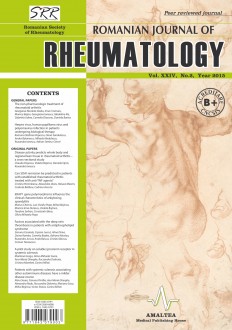SELECT ISSUE

Indexed

| |

|
|
|
| |
|
|
|

|
|
|
|
|
|
| |
|
|
HIGHLIGHTS
National Awards “Science and Research”
NEW! RJR has announced the annually National Award for "Science and Research" for the best scientific articles published throughout the year in the official journal.
Read the Recommendations for the Conduct, Reporting, Editing, and Publication of Scholarly work in Medical Journals.
The published medical research literature is a global public good. Medical journal editors have a social responsibility to promote global health by publishing, whenever possible, research that furthers health worldwide.
FACTORS ASSOCIATED WITH THE DEEP VEIN THROMBOSIS IN PATIENTS WITH ANTIPHOSPHOLIPID SYNDROME
Simona Caraiola, Ciprian Jurcut, Alina Dima, Doina Ramba, Camelia Badea, Adriana Nicolau, Ruxandra Jurcut, Anda Baicus, Cristian Baicus and Coman Tanasescu
ABSTRACT
Introduction. Patients with antiphospholipid syndrome (APS) may have a large spectrum of thrombotic clinical events (arterial or venous), but the factors that determine the occurrence of specific clinical manifestation has not been clearly established.
Objective. The aim of the study was to determine the factors associated with a history of deep vein thrombosis (DVT) in patients with APS. We were especially interested to find an association between the criteria and noncriteria antiphospholipid antibodies (APLAs) and the DVT.
Methods. We realized a cross-sectional study, with consecutive enrollment of all patients presented in our department with the diagnosis of APS in the period 2008-2011. From the total of 106 patients for which the demographic, clinical and biological parameters were collected, the assessment of the criteria and non-criteria APLAs was performed in 73 patients.
Results. The mean age at inclusion was 44.7 years, the female-to-male ratio 6.6, and the mean APS disease duration 6.7 years. The majority of the patients included presented with secondary APS (70 patients). Lupus anticoagulant was the most frequent immunological marker used to sustain the diagnosis of APS, found positive in 102 patients (96.2%). The recurrent DVT was more frequently observed in patients with primary APS than in those with secondary APS (p = 0.02). No significant association with DVT was found for the clinical parameters traditionally associated with the risk of thrombosis that we have taken into study: smoking, body mass index (BMI), waist circumference and waist-to-hip ratio. We found a positive association between the DVT history and the positivity for the IgM anti-β2 glycoprotein I antibodies [OR (95%CI) = 6.95 (1.36-35.58), p = 0.01]. The titer of IgG antiprothrombin antibodies and IgG antiphosphatidylethanolamine antibodies was higher in patients with previous DVT [3.0 (0.0-151.0) versus 2.0 (0.0-2.0), p = 0.01, respectively 5.0 (1.0-33.0) versus 3.0 (1.0-7.0), p = 0.01]. In the subgroup of patients with secondary APS, the previous DVT was associated only with the positivity for IgM anti-β2 glycoprotein I antibodies [OR (95%) = 13.63 (1.46-127.15), p = 0.02]. In the same subgroup, the levels of IgG anticardiolipin and the IgG antiphosphatidylethanolamine antibodies were higher in patients with previous DVT [2.0 (0.0-64.0) versus 1.0 (0.0-20.0), p = 0.02, respectively 3.0 (0.0-151.0) versus 2.0 (0.0-7.0), p = 0.03]. In patients with primary APS, the titer of IgG antiprothrombin antibodies was significantly higher when DVT history were present [5.0 (1.0-3.0) versus 3.0 (1.0-7.0), p = 0.01. Only the titer of IgG antiprothrombin antibodies was associated with the history of recurrent thrombosis [5.0 (1.0-3.0) versus 3.0 (1.0-7.0), p = 0.01]. Conclusions. In patients with APS, the DVT history was related with the prevalence of the anti-β2 glycoprotein I antibodies, but also with the levels of some non-criteria antibodies, IgG antiprothrombin antibodies and IgG antiphosphatidylethanolamine antibodies. In patients with primary APS, previous DVT is associated only with the titer of IgG antiprothrombin antibodies, whereas in patients with secondary APS, the DVT history were related with the presence of anti-β2 glycoprotein I antibodies and with the titers of both criteria antibodies (IgG anticardiolipin antibodies) and non-criteria antibodies (IgG antiphosphatidylethanolamine antibodies). The risk of recurrent thrombosis was higher in patients with primary APS when compared with those with secondary APS. Only the titers of IgG antiprothrombin antibodies were correlated with recurrent thrombosis.
Keywords: antiphospholipid syndrome, antiphospholipid antibodies, deep venous thrombosis
